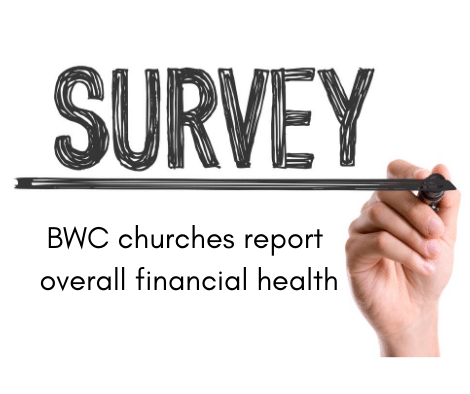Church survey reflects financial health

By Erik Alsgaard
There is no question that the COVID-19 pandemic has impacted all aspects of our lives. Churches throughout the United States have had to adapt to new ways of doing ministry including, of course, churches throughout the Baltimore-Washington Conference.
One of the key areas of adaptation and change can be seen in the finances of our 619 United Methodist churches that make up the BWC.
Conference leaders wanted to know what that financial picture looked like. They also wanted to gather information to help the conference recast its 2021 budget (see story here).
The good news: stewardship and financial support at the local church level remains strong. Churches that responded said that their year-to-date tithes and offerings were averaging 91% against what was budgeted. In addition, churches reported only a 5% drop in tithes and offerings in the first six months of 2020 versus the same time frame in 2019.
In June, a 20-question survey was sent to every church in the BWC, asking them questions such as if they had received Paycheck Protection Program funds from the Federal Government, to when they expected to re-open for any kind of in-person worship.
Dave Schoeller, Business Data Analyst for the BWC, compiled the results, which were recently released. The vast majority – 87% -- of churches in the conference responded.
The good news: stewardship and financial support at the local church level remains strong. Churches that responded said that their year-to-date tithes and offerings were averaging 91% against what was budgeted. In addition, churches reported only a 5% drop in tithes and offerings in the first six months of 2020 versus the same time frame in 2019.
"It was heartening to see how well many of our churches are weathering this storm,” Scholler said. “Availing themselves of federal assistance, shifting to online worship formats, and implementing electronic giving."
Showing what Bishop Easterling now calls two of the key components in doing ministry in this time – being flexible and nimble – churches throughout the conference added online giving as a component of their stewardship. Before the pandemic, survey results indicate that 42% of BWC churches had online giving. About 30% of churches throughout the conference added online giving after the pandemic hit.
One of the ways churches were able to achieve a strong financial showing was through the Paycheck Protection Program (PPP), offered through the Federal Government. More than half – 58% -- of BWC churches applied for PPP, with 51% of the BWC churches receiving the funding. The Baltimore-Washington Conference also applied and received PPP funding. Of those churches who did apply, 86% received funding.
Survey results also showed that churches who responded expected to be able to contribute 80.5% of their Mission Shares in 2020. Mission Shares, once known as “apportionments,” allow local churches to reach beyond their walls and be in ministry in significant ways in their backyards and across the globe.
Congregations also became flexible and nimble by taking their worship services online. Survey respondents indicated that 81% of BWC churches added online worship in some fashion once the pandemic erupted in March.
Most churches, however, seem to be waiting a while before returning to in-person worship again. Forty-seven percent of respondents indicated that they were “uncertain” as to when they would return to in-person worship; 26% anticipated doing this in July, while 15% said “early fall.”
Schoeller said that every church will be e-mailed a personalized copy of the survey results showing their responses along with the summary of responses from both their District and the entire conference.

Great article. Very Well written article on one of the key issues surrounding the viability of our churches. Thank you